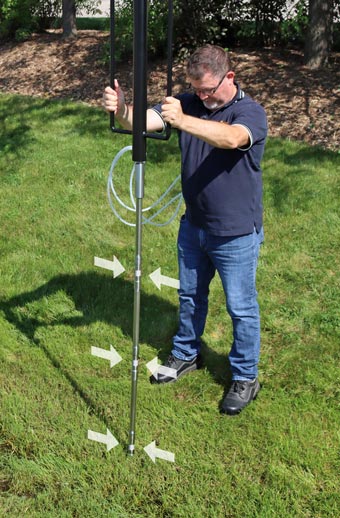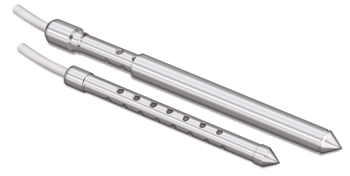Installing Drive-Points with Tubing
The 615 Drive-Point Piezometer can be installed with the tubing already connected to the Drive-Point Piezometer tip with the use of a convenient tubing by-pass along with a drive head assembly and manual slide hammer. The tubing by-pass ensures that the tubing is not damaged while the piezometer is driven to depth.
The sample tubing is cut to length and pushed onto the barb; an extension pipe is slid over the tubing and threaded onto the 615 Drive-Point Piezometer tip; the tubing by-pass is slid over the tubing and tightened onto the extension pipe. The tubing end is extended through the side hole in the tubing by-pass, and out of the way.
The manual slide hammer only contacts the drive head assembly, ensuring the tubing is not damaged. To install to greater depths, extension pipes are added and hammered to depth, each time using the drive head assembly with the tubing by-pass, until the desired depth is reached.
The sample tubing is inserted inside the Peristaltic Pump tubing and the other end into the Drive-Point Piezometer tubing. The friction-fit holds the tubing together. The Model 410 Peristaltic Pump allows sampling up to the suction lift limit, which can be as much as 33 ft. (10 m) at seal level. One easy-access control enables flow rates from 40 ml/min to 3.5 L/min.
Sampling at Contaminated Sites
Model 615 Drive-Point Piezometers provide many benefits when used to sample at contaminated sites, especially when compared to conventional monitoring wells. Because of their portability, quick and simple installation, and controlled sampling, they are excellent to use as an exploration tool for initial site investigations. They can be installed for short term monitoring, and can be used for profiling if installed at a number of different depths on site.
Drive-Point Piezometers are also extremely cost-efficient. There are no drill rigs or large installation tools required; installation and sampling is quick, reducing time in the field; smaller holes mean less purge water and no soil to dispose of; and the few materials that are required, are inexpensive.

Contaminated sites can be quickly, accurately and safely assessed. Drive-Point Piezometers can help determine the existence and location of contaminants. This can help zero in on areas that require immediate remediation without drilling many expensive boreholes. They can also help decide on the placement of more permanent monitoring wells, such as Solinst Multilevel Systems (403 CMT Multilevel Systems, 401 Waterloo Multilevel Systems).
Overall, Model 615 Drive-Point Piezometers and Model 410 Peristaltic Pumps, combined with tubing, tubing by-pass, inexpensive extension rods, drive head assembly and the manual slide hammer, provide a complete groundwater monitoring well solution that is efficient, highly portable and affordable.
Note:
for higher resolution profiling, Solinst offers the Model 615ML Multilevel Drive-Point Piezometer, that allows up to six monitoring zones in one drive.
References
ITRC (Interstate Technology & Regulatory Council), 2006. The Use of Direct-push Well, Technology for Long-term Environmental Monitoring in Groundwater Investigations. SCM-2. Washington, D.C.: Interstate Technology & Regulatory Council, Sampling, Characterization and Monitoring Team. www.itrcweb.org.



